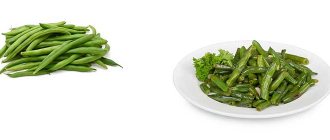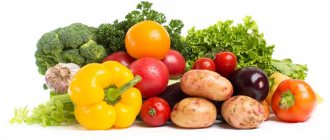A diet rich in dark green leafy vegetables can provide comprehensive benefits to the body, including reducing the risk of obesity, cardiovascular disease, high blood pressure and mental disorders ().
Here is a list of 14 of the healthiest green leafy vegetables to include in your diet.
Kale
Kale is considered one of the most nutrient-dense vegetables on the planet due to the numerous vitamins, minerals and antioxidants it contains.
For example, one 67-gram serving of raw kale contains 684% of the recommended daily intake (RDI) for vitamin K, 206% of the RDA for vitamin A, and 134% of the RDA for vitamin C ().
It also contains antioxidants such as lutein, carotenoids and beta-carotene, which prevent diseases caused by oxidative stress ().
To get the most benefit from eating kale, it is best to eat it raw, as cooking can reduce its nutritional profile ().
Summary:
Kale is rich in minerals, antioxidants, and vitamins, especially vitamins A, C, and K. For the greatest benefits, it is best to eat it raw, as cooking it reduces the vegetable's nutritional profile.
Microgreens
Microgreens are young shoots of vegetable and herb seeds. They are usually 2.5-7.5 cm in length.
Since the 1980s, they have often been used as a garnish or decoration, but they have many more uses.
Despite their small size, they are full of color, flavor and nutrition. In fact, one study found that microgreens contain 40 times more nutrients than their mature counterparts. Some of these nutrients include vitamins C, E, and K ().
Microgreens can be grown at home all year round, making them an easily accessible product.
Summary:
Microgreens are the young shoots of vegetable or herb seeds that have been popular since the 1980s. They are delicious and rich in nutrients such as vitamins C, E and K. Moreover, they can be grown all year round.
Rainbow of healthy foods: green vegetables and fruits
The benefits of vegetables, fruits and herbs are always and everywhere discussed. Absolutely rightly, they are considered the richest sources of vitamins and substances necessary for life. Mother Nature herself gives them to us in their original form to improve the functioning of our body and maintain our appearance in excellent shape.
The bright counters of shops and markets present a wide selection of gifts of nature, which delight us with a variety of colors and colors.
The variety of vegetables, fruits, berries and spices is huge. They can be divided and considered in many categories.
Let's consider the useful and positive qualities that unite natural green products.
Vegetables, fruits, berries and herbs acquire their green color due to the pigment substance chlorophyll they contain. This color itself reduces appetite, has a beneficial effect on the nervous system and psyche, and helps fight stress.
Vegetables
The choice is huge: cabbage (all types), cucumbers, green leafy salads, green zucchini, spinach, green peas, beans, green beans, olives, green peppers, rhubarb, artichoke, asparagus and others.
Fruits
Green apples and pears, lime, kiwi, avocado, green grapes, gooseberries and others.
Spicy vegetables and herbs
Onions, wild garlic, garlic, dill, parsley, celery, tarragon (tarragon), marjoram, mint, lemon balm and others.
Composition of green products
The green group of products is characterized by a high content of vitamins (A, C, D, E, K, P, PP, group B) and microelements (iron, calcium, potassium, phosphorus, magnesium, sulfur, zinc), which makes it possible to compensate for their deficiency in the body , especially in the cold season, reduces the risk of various diseases.
Antioxidants contained in green vegetables and fruits support and enhance immunity, promote the smooth functioning of all organs, and slow down the aging process of the body.
A high level of fiber promotes early satiety, leaves you feeling full for a long time, removes harmful substances, normalizes metabolism, improves the functioning of the digestive system, which greatly contributes to improving the condition of the skin, complexion, hair and nails.
Consumption of products belonging to the green group reduces the negative effects of ultraviolet rays. Helps improve vision and reduce cholesterol levels. Maintains the body's energy balance at a high level.
Green foods are low in calories ; their use is necessary in the process of losing excess weight and preventing many chronic diseases.
Having described healthy green products, let's not forget that all natural products are extremely healthy. In the process of a balanced diet, it is necessary to use products of all color groups.
We will consider their beneficial properties in subsequent publications in the “Rainbow of Healthy Products” series:
— red vegetables and fruits: https://www.yapokupayu.ru/blogs/post/raduga-poleznyh-produktov-krasnye-ovoschi-i-frukty
- yellow-orange vegetables and fruits: https://www.yapokupayu.ru/blogs/post/raduga-poleznyh-produktov-zhelto-oranzhevaya-gruppa-ovoschey-i-fruktov
— blue-violet group: https://www.yapokupayu.ru/blogs/post/raduga-poleznyh-produktov-sine-fioletovye-tsveta-zdorovya-i-krasoty
— white-brown group: https://www.yapokupayu.ru/blogs/post/raduga-poleznyh-produktov-belo-korichnevyy-tsvet-zdorovya-aktivnosti-privlekatelnosti
Broccoli
Broccoli is part of the cabbage family. This green vegetable has a large flower head as well as a stem, making it similar in structure to cauliflower.
This vegetable is rich in nutrients - a 91 gram serving of raw broccoli contains 135% and 116% of the RDA for vitamins C and K, respectively. It is also an excellent source of fiber, calcium, folic acid and phosphorus ().
Of all the vegetables in the cabbage family, broccoli is rich in the plant compound sulforaphane, which may improve your gut bacterial flora and reduce your risk of cancer and heart disease ().
In fact, sulforaphane may even reduce symptoms of autism.
One randomized, double-blind study of 26 young adults with autism observed positive effects on behavioral symptoms after taking a broccoli sprout-derived sulforaphane supplement ().
You can learn more about the benefits of broccoli for the human body on this page - Broccoli: health benefits and harms.
Summary:
Broccoli is part of the cabbage family and contains several nutrients, including the plant compound sulforaphane, which may reduce your risk of heart disease and cancer, and improve your gut flora and even autism symptoms.
The most popular green vegetables
So, what are the different green vegetables? We present to your attention a list of the most popular of them.
Avocado
Alligator pear, or avocado, contains vitamins A, C, E, PP and group B. The micro- and macroelements present in avocados have a beneficial effect on the body. Alligator pear is recommended for heart pathologies and gastrointestinal disorders. Regular consumption of avocados restores water-salt balance and prevents the aging process.
Avocado fruits are actively used in cooking, dietetics and cosmetology.
Broccoli
We can talk endlessly about the benefits of broccoli. The product lowers cholesterol levels in the blood and restores elasticity to blood vessels, increases heart performance and reduces the risk of heart attacks and strokes. As a type of cabbage, broccoli improves digestion and effectively fights constipation. But most importantly: broccoli prevents the formation and spread of cancer cells in the human body.
Broccoli has high anti-cancer properties
Brussels sprouts
Brussels sprouts, whose calorie content is only 43 kcal per 100 g, are actively used in dietetics. Consumption of the product is recommended for the prevention and treatment of viruses, infections, asthma, bronchitis and other pathologies of the upper respiratory tract. A vegetable rich in folic acid reduces the risk of birth defects in infants.
Green radish
Few people know that regular consumption of green radish reduces blood sugar levels. For this reason, the product is prescribed for diabetes. Radish is indispensable for gastrointestinal diseases. However, it is better for people with duodenal ulcers not to abuse the product.
It's no secret that carotene improves vision. Green radish, rich in carotene, is recommended for eye diseases.
Green pea
Peas are consumed in fresh, canned and processed forms. The product contains B vitamins, so it is included in the diet for disorders of the nervous system. The biochemical composition of peas contains vitamin K, which activates metabolism, strengthens bones and joints, and is also responsible for blood clotting.
Green pea
Green radish
Brussels sprouts
Green pepper
Doctors and nutritionists recommend eating green pepper every day. The vegetable contains vitamins A, C, E and group B, minerals and essential oils, folic and nicotinic acids, carotene. The alkaloid capsaicin included in the product stimulates the functioning of the stomach and pancreas, stimulates appetite and promotes better absorption of food.
Zucchini
Zucchini contains a large amount of pectin, so they are often consumed when the digestive system is not functioning properly. Zucchini is recommended for the first feeding of infants.
The product contains vitamin E, which prevents premature aging and helps the body fight free radicals. Vitamin C and beta-carotene, in turn, help strengthen the immune system. Zucchini is one of the main ingredients in the diet for viral and infectious diseases.
White cabbage
The nutritional value of white cabbage is 27 kcal per 100 g. The vegetable contains vitamins A, C, K, PP, B1, B2, B5 and U. Vitamin U, according to scientists, prevents the development of stomach and intestinal ulcers. The low-calorie vegetable is used for obesity, chronic gastritis, and pathologies of the spleen and liver.
If the body is predisposed to stomach disorders, vegetable consumption is minimized. White cabbage is contraindicated in case of increased acidity of gastric juice.
White cabbage
Zucchini
Green pepper
Romanesco cabbage
Romanesco, or Roman cabbage, is rich in fiber, carotenoids and antioxidants. The vitamin K contained in the product restores the elasticity of blood vessels and prevents the formation of blood clots. Fiber improves intestinal motility and relieves constipation. To avoid increased gas formation, the vegetable is consumed in moderation.
Romaine cabbage is rich in carotene and zinc minerals
Kohlrabi
Another healthy green vegetable is kohlrabi cabbage. The product is useful for pathologies of the liver, kidneys, stomach, intestines and gall bladder. Can also be used for viral and infectious diseases.
A decoction of kohlrabi tops is prescribed for asthma and pulmonary tuberculosis.
Kohlrabi stem fruit is used in baby food
Leek
The absence of a strong smell and taste allows you to use leeks for preparing a variety of snacks and salads. But consuming the product fresh is contraindicated in case of inflammatory processes in the intestines and stomach.
Leeks are effective for the prevention and treatment of atherosclerosis, rheumatism, gout and urolithiasis. Prevents the development of sclerotic diseases.
Luffa
Luffa is a member of the Cucurbitaceae family. Unripe fruits are used to make washcloths, which help fight stretch marks and cellulite. Luffa washcloths have a lymphatic drainage effect, cleanse the skin and stimulate blood circulation.
Cucumber
Cucumber removes waste, toxins and excess fluid from the body, slows down the aging process and prevents the formation of kidney stones. Consisting of almost 98% liquid, the vegetable has increased cleansing abilities, so it is often part of the diet.
Cucumber
Luffa
Leek
Chinese cabbage
Chinese cabbage is actively used in folk medicine. The vegetable is recommended for anemia and high blood cholesterol levels. Cabbage prevents the development of hypertension and atherosclerosis. Can be used for frequent headaches and nervous disorders.
Chinese cabbage strengthens the immune system
Savoy cabbage
Savoy cabbage must be present in the diet of older people. The product improves blood composition and normalizes blood pressure, and also prevents the appearance of cancer cells. In addition, savoy cabbage strengthens the immune system.
Savoy cabbage improves the functioning of the digestive system
Celery
Celery is a unique vegetable, since not only the root, but also the green part of the plant has beneficial and medicinal properties. The celery diet is highly effective. The root vegetable is recommended to increase potency in men and restore reproductive function in women. Celery juice has a beneficial effect on the digestive system and also prevents the deposition of salts.
Asparagus
Asparagus, as asparagus shoots are called, can be eaten raw, baked or boiled. The product, rich in water and fiber, is indispensable for a cleansing diet. The vegetable promotes the rapid elimination of toxins, waste and excess fluid. In addition, asparagus has a positive effect on male potency.
Green beans
Green beans are easily absorbed by the body. The product is often called a source of vital energy. Regular consumption of green beans is recommended for depression and other nervous system disorders.
However, if you have a history of gastritis, colitis, stomach ulcers or cholecystitis, it is better to avoid using the product.
Green beans
Asparagus
Celery
Zucchini
European zucchini is what zucchini is called. The vegetable contains a large amount of pure water, so it is included in the diet if you are overweight. The product is easily and quickly absorbed by the body. Zucchini is indispensable for pathologies of the heart, blood vessels, liver, kidneys and stomach.
Unlike zucchini, zucchini can be eaten raw.
Cabbage
Collard greens are also a member of the cabbage family and are related to kale and cabbage. It has slightly bitter, dense leaves that are similar in texture to regular cabbage.
Kale is a good source of calcium and vitamins A, B9 (folic acid), and C. Among other green leafy vegetables, it is also one of the best sources of vitamin K. In fact, one 190 gram serving of cooked kale contains 1,045% of the RDA for vitamin K ( ).
Vitamin K is known for its role in blood clotting. In addition, there is increasing research into its ability to improve bone health ().
One study that looked at 72,327 women aged 38-63 found that those with vitamin K intakes below 109 mcg per day had a significantly increased risk of hip fractures, suggesting a link between this vitamin and bone health () .
Summary:
Collard greens have dense leaves and a slightly bitter taste. It is one of the best sources of vitamin K and may reduce the risk of blood clots and promote healthy bones.
The research results are encouraging
A large review was recently published on the effect of vegetable consumption on the development of heart and vascular diseases. Separate sections in it are devoted to green leafy vegetables and cruciferous vegetables. For their analysis, the authors found 14 large studies that examined the relationship of leafy vegetables with cardiovascular disease, atherosclerosis, coronary artery disease, heart disease and stroke. Most of them showed a beneficial effect. Here are some telling numbers. Those who consumed more leafy vegetables:
— mortality from cardiovascular diseases was 51% less likely;
- IHD and myocardial infarction were 12-22% less likely;
- strokes were 11% less likely;
- strokes were 38% less likely to lead to death.
There were even more studies on green vegetables from the cruciferous family - 26, and most of them also found a beneficial effect on the heart and blood vessels. For example, thanks to them, mortality from cardiovascular diseases decreased by 20-36%, and people became ill with them less often by 12%.
“Two hours of walking - plus seven years of life.” Doctor on preventing heart disease Read more
Spinach
Spinach is a popular green leafy vegetable that can be easily incorporated into a variety of dishes, including soups, sauces, smoothies and salads.
Its nutritional profile is impressive - one 30 gram serving of raw spinach contains 181% of the RDA for vitamin K, 56% of the RDA for vitamin A and 13% of the RDA for manganese ().
It is also rich in folic acid, which plays a key role in the production of red blood cells and the prevention of neural tube defects during pregnancy ().
One study looking at spina bifida (incomplete closure of the neural tube) found that one of the most preventable risk factors for this condition was low folic acid intake during the first trimester of pregnancy ().
Along with taking a prenatal vitamin, eating spinach is a great way to increase your folic acid intake during pregnancy.
You can learn more about the beneficial properties of spinach on this page - Spinach: health benefits and harm.
Summary:
Spinach is a popular green leafy vegetable that can be used in a variety of ways. It is an excellent source of folic acid, which can prevent neural tube defects such as spina bifida during pregnancy.
Cabbage
Cabbage consists of clusters of dense leaves that are colored in shades of green, white and purple.
It belongs to the plant genus Cabbage (lat. Brassica), along with Brussels sprouts, kale and broccoli ().
Vegetables in this plant family contain glucosinolate, which gives them a bitter taste.
Animal studies have shown that foods containing this substance may have anti-cancer properties, especially against lung and esophageal cancer (,).
Another benefit of cabbage is that it can be fermented and made into sauerkraut, which has numerous health benefits such as improving your digestion and supporting your immune system. It may even help you lose weight (, , , ).
Summary:
Cabbage has dense leaves and different colors. It can prevent cancer and can be made into sauerkraut, which has additional health benefits.
Beet tops
Since the Middle Ages, beets have been considered beneficial for health.
Indeed, they have an impressive nutritional profile, but while beets are commonly used in a variety of dishes, the leaves are often overlooked.
This is unfortunate, given that they are edible and rich in potassium, calcium, riboflavin, fiber and vitamins A and K. A 144 gram serving of cooked beet tops contains 220% of the RDA for vitamin A, 37% of the RDA for potassium and 17% of the RDA for fiber ( ).
They also contain the antioxidants beta-carotene and lutein, which have been shown to prevent eye diseases such as macular degeneration and cataracts (,).
Beet tops can be added to salads, soups, or fried and eaten as a side dish.
Summary:
Beet tops are the edible green leaves of beets. They are full of nutrients, including antioxidants, that can support eye health.
Common beetroot (watercress)
The watercress is an aquatic plant in the Brassica family and thus similar to arugula and other mustard greens.
It is known for its healing properties and has been used medicinally for centuries.
Studies have shown that watercress extract is beneficial in targeting cancer stem cells and impairing cancer cell reproduction and invasion (,).
With its bitter and slightly spicy taste, watercress is an excellent addition to neutral-tasting foods.
Summary:
The watercress has been used in medicine for centuries. Some studies have shown that watercress may be beneficial in treating cancer.
Roman salad (Romaine lettuce)
Romaine lettuce (romaine, romaine, romaine, romaine) is a common green leafy vegetable with firm, dark leaves with a hard center.
It has a crunchy texture and is a popular salad addition, especially in Caesar salad.
It is a good source of vitamins A and K - one 47 gram serving provides the body with 82% and 60% of the RDA for these vitamins, respectively ().
Moreover, studies have shown that water intake from liquids, vegetables and fruits plays an important role in reducing excess body weight ().
So with only 8 calories and 45 grams of water per serving, romaine lettuce can be a great addition to a healthy diet if you're trying to lose weight ().
Summary:
Romaine lettuce is a popular vegetable that can be found in many salads. It is full of water and fiber, making it a great weight loss product. It is also rich in vitamins A and K.
Green diet from a scientific point of view
The green diet, in addition to being low in calories and the ability to speed up metabolism, has another valuable dietary quality - the foods it contains suppress appetite.
Numerous studies by psychologists have shown that foods with bright colors (red, yellow, orange), as well as shiny dishes (for example, sprinkled with butter, glaze, gelatin or sauce) stimulate appetite at a subconscious level. Whereas products of calm shades, and especially green tones, do not cause pronounced impulses to eat. In other words, a red bell pepper looks much more appetizing to our brain than the same one, but green. Therefore, if you want to eat less, not overload your stomach and gradually lose excess weight, it makes sense to choose green foods. They should form the basis of a green diet.
What do nutritionists say about the benefits of green foods? In one chorus they are definitely in favor of eating fresh vegetables and green fruits.
In addition to the fact that green diet products are rich in nutrients and are well digestible, many of them (for example, cucumbers, cabbage, green apples, pears, quinces) contain a “magic” substance - tartronic acid. The beauty of this acid is that it sharply slows down the process of lipogenesis - that is, the conversion of carbohydrates into fats.
Strictly speaking, by saturating your menu with products containing tartronic acid, you will leave your body almost no chance to accumulate fat.
Swiss chard
Swiss chard has dark green leaves with thick stems that are red, white, yellow or green. It is often used in Mediterranean cuisine and belongs to the same family as beets and spinach.
It has an earthy flavor and is rich in minerals and vitamins such as potassium, manganese and vitamins A, C and K ().
Swiss chard also contains a unique flavonoid called syringic acid, a compound that may be helpful in lowering blood sugar levels ().
In two small studies in diabetic rats, oral administration of syringic acid for 30 days improved blood sugar levels (, ).
However, it is important to note that these were small animal studies, and that there are no human studies to support the claim that syringic acid can help control blood sugar.
Try adding all parts of Swiss chard to dishes such as soups, tacos, or casserole.
Summary:
Swiss chard is rich in color and is often included in Mediterranean cuisine. It contains a flavonoid called syringic acid, which may be helpful in lowering blood sugar levels. However, there are no human studies regarding its effectiveness.
Anti-allergenic vitamins
The list of green vegetables and fruits looks tasty and pretty: kiwi, green grapes, green apples and pears, avocado, broccoli, spinach, asparagus, celery, zucchini, cucumbers, sweet green peppers, peas, green beans, green onions, lettuce, parsley , dill.
What is common and useful about them? News on the topic Scientists have named the optimal ratio of vegetables and fruits for every day “The benefit of green vegetables and fruits is that they are not as allergenic as, for example, red or orange fruits. This is their important advantage. In addition, they, like all vegetables and fruits, contain dietary fiber. We are, of course, talking about vegetables and fruits, raw or as unprocessed as possible. Dietary fiber has a positive effect on intestinal motility, cleansing its walls. After all, there are small villi in the intestines, in which, due to improper nutrition, toxins and small food residues accumulate. If we talk about cruciferous vegetables - all types of cabbage, including cabbage, broccoli, cauliflower, Brussels sprouts, Peking cabbage, etc. – then they are rich in a lot of microelements necessary for the body. And greens contain a lot of vitamins C and zinc. Green fruits contain fructose, which prevents many diseases. Scientists from the American Institute in Minnesota, as a result of a study, came to the conclusion that green kiwi (there are also other types of this fruit) helps with the problem of constipation and is considered a good prophylactic product for the prevention of constipation. Baked green apples can even be consumed by people suffering from gastritis and stomach ulcers,” says nutritionist Ekaterina Cherkasskaya.
But, in her opinion, you shouldn’t limit your menu to only green products. Why?
“I am a supporter of the classical school of nutrition. And all the newfangled diets - mono-diets, according to blood types, according to the color of foods, etc. - I do not believe. Plant-based foods are generally very healthy and should be included in your diet every day. And you shouldn’t give preference to any one color. You need to eat different vegetables and fruits - they are nutritious, each is useful in its own way and complements each other, but in general they provide energy, normalize weight, as well as such important indicators as blood pressure, cholesterol and blood sugar,” explains E. Cherkasskaya.
She also advises eating vegetables and fruits that are in season. If it is not possible to buy them in winter, you need to make preparations in the summer - dry and freeze. You can try overseas fruits and vegetables, but you shouldn’t eat exotic foods all the time. After all, each region has its own nutritional characteristics, and it has been repeatedly proven that crops grown on one’s own land are more beneficial for the body. However, everyone should not adhere to the same rules of nutrition, since it is individual, depends on taste, habits that were developed during childhood at family dinners, and preferences. And for some, it makes sense to introduce more imported avocados into their menu, since they contain a lot of healthy vegetable fats, while others, perhaps, should not get carried away with something that is 100% ours and has earned the reputation of being a very healthy product like sauerkraut. After all, it may contain too much salt, sugar and vinegar, which is harmful for some diseases, as well as for excess weight, since it stimulates appetite.
Arugula (Arugula)
Arugula is a green leafy vegetable from the Brassica family that goes by many different names, such as Arugula sativum, Indau sativum or Eruca sativum.
It has a slightly peppery flavor and small leaves that can easily be included in salads or used as a garnish. It can also be used for cosmetic purposes and as a medicine ().
Like other green leafy vegetables, it is rich in nutrients such as vitamins A, B9 and K ().
It is also one of the best sources of dietary nitrates, compounds that are converted into nitric oxide in your body.
Although the benefits of nitrates are debated, some studies have found that they may help increase circulation and lower blood pressure by dilating blood vessels ().
Summary:
Arugula is a green leafy vegetable that goes by several different names. It is rich in vitamins and natural nitrates, which can help lower blood pressure and improve blood flow.
Asparagus
Long asparagus shoots belong to the lily family and are relatives of onions, are rich in mineral complex and vitamins, and also contain unique substances: asparagine and saponin, which synthesize protein. Also, asparagusic acid is considered indispensable for kidney diseases, which, together with potassium, promotes the removal of decay products, has a diuretic property, normalizes the functioning of the genitourinary system, and increases male potency.
The active substance asparagine increases vascular permeability, which helps lower blood pressure and serves as a prevention of thrombosis and phlebitis. Young tender shoots are eaten raw, and can also be steamed, baked or grilled as an independent dish, soup, omelet or as part of a complex side dish, added to a salad or vinaigrette. Asparagus is also often canned and pickled, and then used throughout the year.
The calorie content of shoots is 20 kcal, most of which is water, so asparagus is often included in cleansing diets. But this hypoallergenic healthy product has its contraindications for diseases or ulcers of the stomach and intestines, diabetes, cystitis, articular rheumatism and prostatitis, as it can provoke acute attacks or exacerbation.
Endive
Endive belongs to the Chicory family. It is less known than other green leafy vegetables, perhaps because it is difficult to grow.
It is curly, crunchy in texture and has a nutty and slightly bitter taste. It can be eaten raw or cooked.
Just a 25-gram serving of raw endive leaves contains 72% of the RDA for vitamin K, 11% of the RDA for vitamin A and 9% of the RDA for folic acid ().
It is also a good source of kaempferol, an antioxidant that has been shown in test-tube studies to reduce inflammation and inhibit the growth of cancer cells (,).
Summary:
Endive is a lesser known green leafy vegetable. It contains several nutrients, including the antioxidant kaempferol, which may reduce the growth of cancer cells.
Green pea
The list of green vegetables should be continued with sweet and aromatic green peas, which are loved by both adults and children. The vegetable was first grown in India more than 5,000 years ago, and today it is loved all over the world. And not only for its gastronomic properties, but also for its exceptional benefits, which are expressed in the following:
- Peas are high in folic acid, vitamins K and B6, as well as lutein. This “cocktail” keeps the heart muscle toned and strengthens the walls of blood vessels.
- Fiber has the ability to regulate metabolic rate. The substance promotes the removal of toxins and improves intestinal motility.
- Peas contain a lot of manganese, as well as half the daily value of vitamin K. This combination helps strengthen bones and prevents calcium loss.
- The plant pigment lutein in combination with vitamin A prevents a decrease in visual acuity. Regular consumption of peas protects the retina from damage.
Unfortunately, not everyone is recommended to indulge in sweet green peas. It contains substances that can worsen gout symptoms. People suffering from kidney stones should also avoid this vegetable.
Bok Choy
Bok choy is a type of Chinese cabbage.
It has thick, dark green leaves that make a great addition to soups and stir-fries.
Bok choy is one of the few leafy green vegetables that contain the mineral selenium. Selenium plays an important role in cognitive function, immunity, and cancer prevention ().
Additionally, selenium is important for proper thyroid function. This gland is located in the neck and produces hormones that play a key role in metabolism ().
An observational study has linked low selenium levels to thyroid diseases such as hypothyroidism, autoimmune thyroiditis, and thyroid enlargement ().
Summary:
Bok Choy is popular in China and is often used in soups and stir-fries. It is one of the only green vegetables that contains selenium, which benefits your brain and thyroid health, as well as strengthening your immune system and protecting against cancer.
Cucumber
Among green vegetables, the most popular is the juicy, refreshing cucumber. This is an invariable component of summer salads and a wonderful light snack. Vegetables provide the body with the following benefits:
- Fights dehydration. A cucumber is 95% water. The fruit helps replenish the lack of life-giving moisture, which has a positive effect on the functioning of internal organs and the condition of connective tissue.
- Eliminates swelling. This can be achieved thanks to its mild diuretic effect.
- Prevents obesity. Tatronic acids prevent the transformation of carbohydrates into adipose tissue.
- Prevents the formation of kidney stones. Salts restore the acid-base balance, removing all excess from the bladder and kidneys.
- Heals the thyroid gland. This function is provided by the increased iodine content.
The watery texture of the cucumber is both an advantage and a danger of the vegetable. The fruit is prone to the accumulation of harmful substances from the soil and environment. Therefore, you need to eat only cucumbers from your own garden or purchased from trusted summer residents.
Turnip tops
Turnip tops are the greens of the turnip plant, which is a root vegetable similar to potatoes.
These green leaves contain more nutrients than turnip root itself, including calcium, manganese, folic acid and vitamins A, C and K ().
They have a strong and spicy flavor and are often eaten cooked rather than raw.
Turnips are considered a cruciferous vegetable that has been shown to reduce the risk of developing diseases such as cardiovascular disease, cancer, inflammation and atherosclerosis (, ,).
Turnip greens also contain several antioxidants, including gluconasturtin, glucotropaolin, quercetin, myricetin, and beta-carotene, which play a role in reducing stress in your body ().
Turnip tops can be used as a substitute for kale or spinach in most recipes.
Summary:
Turnips are a cruciferous vegetable, the roots and tops of which are eaten. Research has shown that turnip greens can reduce stress in the body and the risk of cardiovascular disease, cancer, atherosclerosis and inflammation.
Product groups by color
Red group of products The red group includes: meat (beef, veal), red fish (salmon, pink salmon), red bell peppers, tomatoes, pomegranate, cherries, radishes, pink grapefruit, strawberries, red apples, red grapes, raspberries, cranberries, watermelon, rhubarb, hibiscus tea... General effect on the body: products from this group charge you with energy and stimulate activity. Nutrients of red foods: flavonoids, lycopene, phenol, vitamin C.
- Flavonoids protect the body from the formation of cancer cells, fight free radicals, prevent the destruction of cell membranes, and are responsible for good memory and sharp vision.
- Lycopene cleanses the body, normalizes blood composition and also helps in the fight against cancer.
- Phenol is an antioxidant and helps fight depression.
- Vitamin C improves immunity, helps fight viral infections, and has a beneficial effect on the skin.
Orange group of products The orange group includes: pumpkin, orange bell peppers, carrots, apricots, mangoes, sea buckthorn, persimmons, oranges, tangerines, orange zucchini, russula... General effects on the body: products cause a surge of energy, including sexual energy, strengthen the immune system , improve blood circulation and digestion. Nutrients of orange products: vitamin C, beta-keratin, pectin.
- Beta-carotene removes toxins, promotes hematopoiesis, improves vision and skin condition, and strengthens the nervous system.
- Pectin also has antioxidant properties and normalizes the functioning of the gastrointestinal tract.
Yellow group of products The yellow group includes: pineapple, corn, sweet peppers, yellow melon, squash, yellow cheese, bananas, yellow plum, yellow grapefruit... General effect on the body: products strengthen the nervous system, activate the liver and gastrointestinal tract, have antipyretic properties. Nutrients of yellow products: vitamin A and B vitamins.
- Vitamin A (retinol) improves the condition of skin and hair, has a beneficial effect on vision, increases the level of “good” cholesterol and alleviates angina pectoris.
- B vitamins strengthen the nervous system, respiratory organs, promote energy production, restore hormonal levels, and act as an antioxidant.
Green group of products The green group includes: cucumbers, cabbage (broccoli, Brussels sprouts, seaweed), green grapes, lettuce, avocado, green peas, asparagus, green apples, kiwi, fresh herbs (parsley, onion, dill), green bell peppers, spinach, zucchini, green beans... General effect on the body: products restore emotional balance, relax in stressful situations, normalize blood pressure, treat headaches. Nutrients of green products: chlorophyll, iron, isothiocyanates, sulforaphane.
- Chlorophyll helps relieve stress and headaches.
- Iron helps oxygenate the blood.
- Isothiocyanates and sulforaphane have anticancer properties.
- Also, many green vegetables are sources of zeaxanthin and lutein, folic acid and beta-carotene, which protect the eyes and thyroid gland from the harmful effects of UV rays.
Blue group of products The blue group includes: pike perch, blue carp, skim milk, oysters, squid, blue cheese, blueberries, mushrooms. General effect on the body: products promote clarity and clarity of thinking, help with weight loss, and slow down the aging process. Nutrients of blue products: pterostilbene, enzymes.
- Pterostilbene slows down the development of colon cancer, normalizes blood pressure, lowers cholesterol, and promotes weight loss.
- Enzymes improve metabolism and the digestion process.
Blue group of products The blue group includes: blueberries, blue plums, dates, blueberry yogurt, oysters, greenlings, blue grapes. General effect on the body: have a calming effect, normalize sleep, help fight inflammatory processes and diseases of veins and blood vessels. Nutrients of blue products: zinc, anthocyanin.
- Zinc is needed for the production of testosterone and other hormones, promotes cell renewal, and strengthens the immune system.
- Anthocyanin reduces the level of bad cholesterol, is necessary for the functioning of the brain (improves memory and coordination) and heart (strengthens the heart muscle and reduces the risk of stroke), promotes healthy sleep and emotional stability.
Purple group of products The purple group includes: red cabbage, grapes, eggplants, purple onions, plums, beets. General effect on the body: products improve the functioning of the respiratory system, help to relax, while sharpening thinking. Nutrients of purple products: potassium, pectin, resveratrol.
- Potassium is necessary for the normal functioning of the heart, prevents the likelihood of chronic fatigue, and is an anti-sclerotic agent.
- Pectin has antioxidant properties, normalizes the functioning of the gastrointestinal tract, and improves blood composition.
- Resveratrol has antiallergic properties.
Based on the division of foods into color groups, a special color diet has been developed, where each day of the week corresponds to a specific color of the foods consumed. Nutritionists say that in 2 weeks of such a diet you can lose 5-10 kg.
Summarize
- Green leafy vegetables are rich in important and powerful nutrients that are critical to good health.
- Luckily, many leafy green vegetables can be found year-round and can be easily incorporated into your meals.
- To reap many of the impressive health benefits of leafy greens, be sure to include a variety of the vegetables on this list in your diet.
The article was prepared by experts for informational purposes only. It should not be used as a guide for treating medical conditions and is not a substitute for professional medical advice, diagnosis, or treatment. In case of illness or any symptoms, you should always consult a doctor and not self-medicate.
About the author: Alexander Fedorov
Candidate of Biological Sciences, biologist, nutrition expert. Graduated from Stavropol State University with a degree in Biology at the Faculty of Biology and Chemistry.
- Related Posts
- Sorrel: beneficial properties and contraindications
- What is Chinese black tree mushroom and is it healthy?
- Artichoke and artichoke extract: beneficial properties and contraindications
« Previous entry
Why you should eat green fruits
Scientists have concluded that green vegetables are the least popular. It is believed that this color is unattractive from the point of view of awakening the appetite. However, your opinion will change if you find out what benefits green fruits provide to the body:
- Supports heart function. Green color is a sign of increased magnesium content, which supports the functioning of the main “motor” in the body and also increases the tone of the muscular system.
- Cleanses blood vessels. Substances in green vegetables free the circulatory system from “bad” cholesterol. This reduces the risk of developing cholesterol plaques.
- Normalizes intestinal motility. Water and fiber promote the active movement of food through the gastrointestinal tract with the subsequent removal of toxins.
- Burning calories. Juicy green vegetables are characterized by “negative” calorie content. More calories are spent on digesting them than they enter the body. Thus, by including these foods in your diet, it is easier to achieve slimness.











